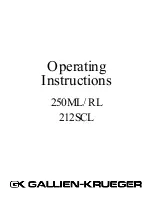
38
Optimizing the detector
AZURA® Detector DAD 6.1L, DAD 2.1L, MWD 2.1L Instructions, V6700
The selection of bandwidth is a balance between sensitivity and selecti-
vity. Narrow bandwidths increase selectivity, whereas broad bandwidths
increase sensitivity.
By default (see section „5.5 Default settings“ on page 31), the band-
width for the signal wavelength is set to 8 nm and for the reference wave-
length the bandwidth is set to 30 nm.
6.4 Spectral range
When measuring with chromatography software, the spectral range selec-
ted for a given measurement influences the required disc space. The disc
space is necessary to save generated data.
A narrow spectral range reduces disk space. The range, however, should
be wide enough to ensure the detection of all components. Also, the
spectral range always must include the signal wavelength and the refe-
rence wavelength (when applicable).
6.5 Time constant & data rate
The time constant influences the response time of the detector. The res-
ponse time determines how quickly the detector responds to a change
in signal. A good rule of thumb for selection of the time constant is that it
should be no larger than
1
/
10
of the baseline peak width of the first peak
of interest (in seconds). Increasing the time constant allows more avera-
ging of the signal (also known as digital filtering) and results in less base-
line noise. However, increasing the time constant too much may result in
broad peaks, reduced peak heights and asymmetric peak shapes. There-
fore, a compromise has to be found.
Using the time constant a signal smoothing can be achieved. The larger
this value is set, the more the signal will be smoothed. In general, the
best time constant is the reciprocal of the data rate (see table below). If
increa sed sensitivity is desired, or if the baseline noise is interfering with
integra tion, the time constant should be increased. If resolution is com-
promised, it should be decreased.
It is recommended to set the time constant and data rate in relation to
peak width.
Peak width [min]
Time constant
[s]
Data rate
[Hz]
<0.003
0.01
100
>0.007
0.02
50
>0.017
0.05
20
>0.033
0.1
10
>0.067
0.2
5
>0.167
0.5
2
>0.333
1
1
The data rate (or sampling rate) is the number of data points per second
(Hz) at which the detector transmits data to the computer.
Default bandwidth
Response time
Time constant
Data rate
















































